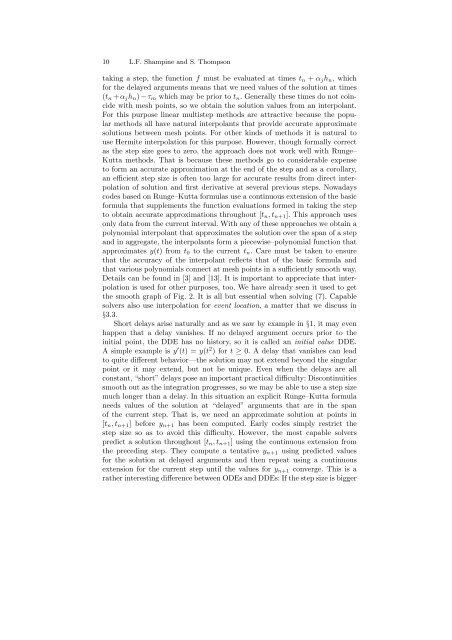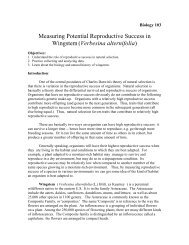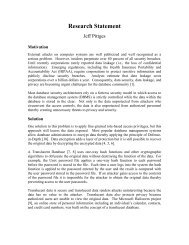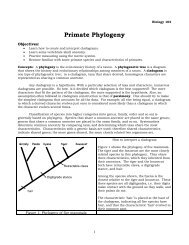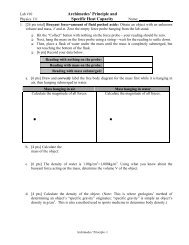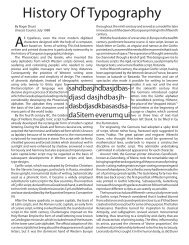Solving Delay Differential Equations - Radford University
Solving Delay Differential Equations - Radford University
Solving Delay Differential Equations - Radford University
You also want an ePaper? Increase the reach of your titles
YUMPU automatically turns print PDFs into web optimized ePapers that Google loves.
10 L.F. Shampine and S. Thompson<br />
taking a step, the function f must be evaluated at times tn + αjhn, which<br />
for the delayed arguments means that we need values of the solution at times<br />
(tn + αjhn) − τm which may be prior to tn. Generally these times do not coincide<br />
with mesh points, so we obtain the solution values from an interpolant.<br />
For this purpose linear multistep methods are attractive because the popular<br />
methods all have natural interpolants that provide accurate approximate<br />
solutions between mesh points. For other kinds of methods it is natural to<br />
use Hermite interpolation for this purpose. However, though formally correct<br />
as the step size goes to zero, the approach does not work well with Runge–<br />
Kutta methods. That is because these methods go to considerable expense<br />
to form an accurate approximation at the end of the step and as a corollary,<br />
an efficient step size is often too large for accurate results from direct interpolation<br />
of solution and first derivative at several previous steps. Nowadays<br />
codes based on Runge–Kutta formulas use a continuous extension of the basic<br />
formula that supplements the function evaluations formed in taking the step<br />
to obtain accurate approximations throughout [tn, tn+1]. This approach uses<br />
only data from the current interval. With any of these approaches we obtain a<br />
polynomial interpolant that approximates the solution over the span of a step<br />
and in aggregate, the interpolants form a piecewise–polynomial function that<br />
approximates y(t) from t0 to the current tn. Care must be taken to ensure<br />
that the accuracy of the interpolant reflects that of the basic formula and<br />
that various polynomials connect at mesh points in a sufficiently smooth way.<br />
Details can be found in [3] and [13]. It is important to appreciate that interpolation<br />
is used for other purposes, too. We have already seen it used to get<br />
the smooth graph of Fig. 2. It is all but essential when solving (7). Capable<br />
solvers also use interpolation for event location, a matter that we discuss in<br />
§3.3.<br />
Short delays arise naturally and as we saw by example in §1, it may even<br />
happen that a delay vanishes. If no delayed argument occurs prior to the<br />
initial point, the DDE has no history, so it is called an initial value DDE.<br />
A simple example is y ′ (t) = y(t 2 ) for t ≥ 0. A delay that vanishes can lead<br />
to quite different behavior—the solution may not extend beyond the singular<br />
point or it may extend, but not be unique. Even when the delays are all<br />
constant, “short” delays pose an important practical difficulty: Discontinuities<br />
smooth out as the integration progresses, so we may be able to use a step size<br />
much longer than a delay. In this situation an explicit Runge–Kutta formula<br />
needs values of the solution at “delayed” arguments that are in the span<br />
of the current step. That is, we need an approximate solution at points in<br />
[tn, tn+1] before yn+1 has been computed. Early codes simply restrict the<br />
step size so as to avoid this difficulty. However, the most capable solvers<br />
predict a solution throughout [tn, tn+1] using the continuous extension from<br />
the preceding step. They compute a tentative yn+1 using predicted values<br />
for the solution at delayed arguments and then repeat using a continuous<br />
extension for the current step until the values for yn+1 converge. This is a<br />
rather interesting difference between ODEs and DDEs: If the step size is bigger


